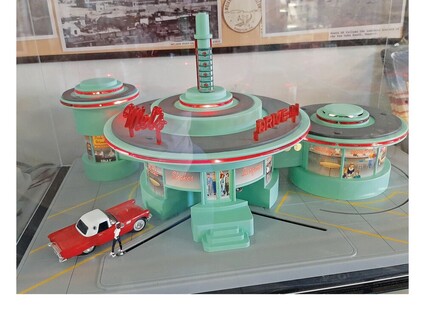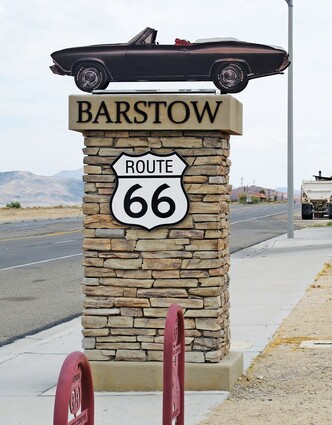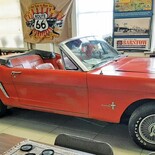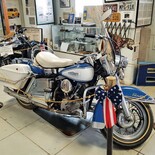The Mother Road Museum in Barstow
Day Trippin' with Mel
August 5, 2023

Mel Makaw.
I have to include a picture of a scale model of Mel's Diner, on display in the Mother Road Museum.
Every time I go from Tehachapi to Laughlin, I pass through Barstow to get on Interstate 40, which parallels a section of the historic Route 66. Occasionally I get off the newer highway system and drive on the old pavement painted with the Highway 66 markings.
The story of Route 66 – and driving on the famous old highway – has always fascinated me. I've been on all parts of that road many times in my lifetime on cross-country trips, and I love the feelings of nostalgia it evokes.
Some history: America's love of the automobile took off in the 1920s and Route 66 (or US 66) was established in November of 1926, one of the first in the new numbered highway system. The highway then became one of the most famous roads in the United States, running from Chicago, Illinois through Missouri, Kansas, Oklahoma, Texas, New Mexico, Arizona, and California, ending at the Santa Monica Pier in Los Angeles. It covered 2,448 miles.
In John Steinbeck's novel The Grapes of Wrath (1939), the highway symbolized "escape, loss, and the hope of a new beginning;" Steinbeck is actually the one who dubbed Route 66 the "Mother Road." It was also sometimes called the "Will Rogers Highway" and "Main Street of America." The highway gained notoriety and popularity with the 1945 song "Get Your Kicks on Route 66" and the "Route 66" television series (1960-64).
Because of the popularity of US 66, economies along the route prospered and communities later fought to keep it alive when the threat of being bypassed (by the more advanced Interstate system) became a reality in the 1960s and 70s. Route 66 was officially removed from the US Highway System in 1985, after it was entirely replaced by the Interstates. The name "Historic Route 66" got put back on maps later as portions of the road have been designated a National Scenic Byway.
A little local history: The Mojave Road and other early trails crossing the desert followed railroad lines once they were established. The roads were rough, full of rocks and sand and ruts of old wagon trails. The newly formed highway system established paved roads, which helped considerably, but the part of Route 66 through our desert was considered the most strenuous and was the last to be paved.
I took off one recent Sunday to visit the Mother Road Museum in Barstow, something I've wanted to do for a while but never got around to. The museum opened in 2000 and continues to collect historic artifacts related to Route 66 (i.e. the Mother Road). I'm so glad I finally got there, and I'm happy to tell you it is a wonderful little museum that is well worth the drive.
There is no cost to visit the museum (a pleasant surprise) and the four rooms of the museum are chock full of road signs, vehicles, collections of memorabilia, artifacts and historic photos and documents. It even includes collections of spark plugs and wrenches, cameras, travel items, and so much more. A volunteer docent is always available to answer questions.
If you go, take the 58 East all the way to Barstow (about 90 miles), then take the Main Street exit (turn right onto Main Street, which is part of the original Route 66). This will take you toward the old downtown. At the traffic light at First Avenue, turn left (east). Go across the bridge over the railroad yard, and the museum (and Harvey House and the Railroad Museum) will be on your right.
Hours for the Museum are Fridays, Saturdays, and Sundays only, 10 a.m. to 3 p.m. (In addition, the Railroad Museum next door is open 11 a.m. to 4 p.m.).
And if you go, enjoy your drive along the recently finished divided Highway 58, with your air conditioner and cruise control on (it was 109 the day I was there). Our highways and traveling conditions have come a long way since the ways and means of yesteryear on the original Route 66.
© 2023 Mel Makaw. Mel, Tehachapi writer/photographer and avid day tripper welcomes your questions, comments, and suggestions at morningland@msn.com.












